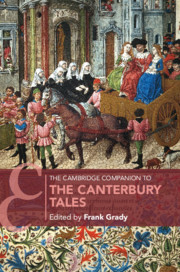Book contents
- The Cambridge Companion to The Canterbury Tales
- The Cambridge Companion to The Canterbury Tales
- Copyright page
- Contents
- Illustrations
- Contributors
- Preface
- Note on the Text
- Chronology
- Abbreviations
- 1 The Form of the Canterbury Tales
- 2 Manuscripts, Scribes, Circulation
- 3 The General Prologue
- 4 The Knight’s Tale and the Estrangements of Form
- 5 The Miller’s Tale and the Art of Solaas
- 6 The Man of Law’s Tale
- 7 The Wife of Bath’s Prologue and Tale
- 8 The Friar’s Tale and TheSummoner’s Tale in Word and Deed
- 9 Griselda and the Problem of the Human in The Clerk’s Tale
- 10 The Franklin’s Symptomatic Sursanure
- 11 The Pardoner and His Tale
- 12 The Prioress’s Tale
- 13 The Nun’s Priest’s Tale
- 14 Moral Chaucer
- 15 Chaucer’s Sense of an Ending
- 16 Postscript: How to Talk about Chaucer with Your Friends and Colleagues
- Further Reading
- Index
- Cambridge Companions to …
16 - Postscript: How to Talk about Chaucer with Your Friends and Colleagues
Published online by Cambridge University Press: 21 August 2020
- The Cambridge Companion to The Canterbury Tales
- The Cambridge Companion to The Canterbury Tales
- Copyright page
- Contents
- Illustrations
- Contributors
- Preface
- Note on the Text
- Chronology
- Abbreviations
- 1 The Form of the Canterbury Tales
- 2 Manuscripts, Scribes, Circulation
- 3 The General Prologue
- 4 The Knight’s Tale and the Estrangements of Form
- 5 The Miller’s Tale and the Art of Solaas
- 6 The Man of Law’s Tale
- 7 The Wife of Bath’s Prologue and Tale
- 8 The Friar’s Tale and TheSummoner’s Tale in Word and Deed
- 9 Griselda and the Problem of the Human in The Clerk’s Tale
- 10 The Franklin’s Symptomatic Sursanure
- 11 The Pardoner and His Tale
- 12 The Prioress’s Tale
- 13 The Nun’s Priest’s Tale
- 14 Moral Chaucer
- 15 Chaucer’s Sense of an Ending
- 16 Postscript: How to Talk about Chaucer with Your Friends and Colleagues
- Further Reading
- Index
- Cambridge Companions to …
Summary
Professional teaching and research devoted to the Canterbury Tales largely developed within the modern research university, and that’s where most students of Chaucer learn the disciplinary languages necessary for participation in the field – Middle English and some of its dialects, a little Latin and French, and the discourses of contemporary literary and cultural criticism. But the institutions that house such study are also the site of administrative, curricular, and budgetary decisions that necessarily affect, at one remove or another, work in the field, so ideally Chaucerians and prospective Chaucerians should acquaint themselves as well with the various institutional languages that can be used to recruit attention, resources, and allies to the cause. Becoming more fluent in the campus languages of success, of assessment, and of strategic plans and self-promotion puts us in the position to more effectively help colleagues, administrators, and students understand the answers they get when they ask the question “why Chaucer?”
- Type
- Chapter
- Information
- The Cambridge Companion to The Canterbury Tales , pp. 232 - 254Publisher: Cambridge University PressPrint publication year: 2020

